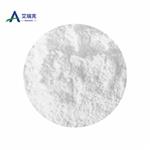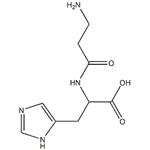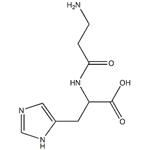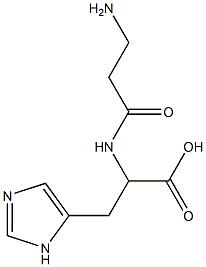Papain
- CAS No.
- 9001-73-4
- Chemical Name:
- Papain
- Synonyms
- arbuz;apain;Velardon;IMMOBILIZED PAPAIN;Papain, Suspension;Papain;caroid;Papase;Vermizym;papainum
- CBNumber:
- CB6135333
- Molecular Formula:
- C9H14N4O3
- Molecular Weight:
- 226.23246
- MDL Number:
- MFCD00131791
- MOL File:
- 9001-73-4.mol
- MSDS File:
- SDS
| Flash point | 29 °C |
|---|---|
| storage temp. | 2-8°C |
| solubility | H2O: soluble1.2mg/mL |
| form | lyophilized powder |
| color | almost white |
| Water Solubility | Soluble in water, insoluble in most organic solvents. |
| Merck | 7016 |
| Stability | Hygroscopic |
| InChI | InChI=1S/C9H14N4O3/c10-2-1-8(14)13-7(9(15)16)3-6-4-11-5-12-6/h4-5,7H,1-3,10H2,(H,11,12)(H,13,14)(H,15,16) |
| InChIKey | CQOVPNPJLQNMDC-UHFFFAOYSA-N |
| SMILES | C(O)(=O)C(NC(=O)CCN)CC1NC=NC=1 |
| FDA 21 CFR | 184.1585; 582.1585; 310.545 |
| Substances Added to Food (formerly EAFUS) | PAPAIN (CARICA PAPAYA L.) |
| SCOGS (Select Committee on GRAS Substances) | Papain |
| EWG's Food Scores | 1-3 |
| FDA UNII | A236A06Y32 |
| EPA Substance Registry System | Papain (9001-73-4) |
SAFETY
Risk and Safety Statements
| Symbol(GHS) |  GHS08 |
|||||||||
|---|---|---|---|---|---|---|---|---|---|---|
| Signal word | Danger | |||||||||
| Hazard statements | H334 | |||||||||
| Precautionary statements | P261-P284-P304+P340-P342+P311-P501 | |||||||||
| Hazard Codes | Xn | |||||||||
| Risk Statements | 42/43-42-36/37/38-20/21/22-10 | |||||||||
| Safety Statements | 36-36/37-26-24-22-45-23-36/37/39 | |||||||||
| WGK Germany | 3 | |||||||||
| RTECS | RU4950000 | |||||||||
| TSCA | Yes | |||||||||
| HS Code | 35079090 | |||||||||
| Toxicity | TDLo orl-man: 71 mg/kg:GIT JCGADC 9,127,87 | |||||||||
| NFPA 704 |
|
Papain price More Price(37)
| Manufacturer | Product number | Product description | CAS number | Packaging | Price | Updated | Buy |
|---|---|---|---|---|---|---|---|
| Sigma-Aldrich | 1495005 | Papain from Carica papaya United States Pharmacopeia (USP) Reference Standard | 9001-73-4 | 1g | $544 | 2024-03-01 | Buy |
| Sigma-Aldrich | 10108014001 | Papain from Carica papaya | 9001-73-4 | 10ml | $117 | 2024-03-01 | Buy |
| Sigma-Aldrich | 5125-50GM-M | Papain, Carica papaya | 9001-73-4 | 50g | $86.1 | 2022-05-15 | Buy |
| Alfa Aesar | J61875 | Papain, Carica Papaya Latex | 9001-73-4 | 25mg | $94.2 | 2023-06-20 | Buy |
| Alfa Aesar | J61875 | Papain, Carica Papaya Latex | 9001-73-4 | 1g | $992 | 2023-06-20 | Buy |
Papain Chemical Properties,Uses,Production
Chemical Properties
cream to light brown powder
Originator
Papain,Green Cross ,Japan,1969
Uses
For tenderizing meats; for clearing beverages; for bating skins.
Uses
Papain is a tenderizer that is a protein-digesting enzyme obtained from the papaya fruit. the enzyme, used in a patented process, is injected into the circulatory system of the live animal and is activated by the heat of cooking to break down the protein, thus tenderizing the beef. the enzyme is inactivated by stomach acids.
Uses
papain is a papaya enzyme able to dissolve keratin. Papain is used in face masks and peeling lotions as a very gentle exfoliant. It can be irritating to the skin but less so than bromelin, a similar enzyme found in pineapples and also used in cosmetics. It is considered a non-comedogenic raw material.
Uses
Papain may cause allergic manifestation .Person handling this material should be protected against inhalation of dust and contact with the skin or eyes.
Definition
papain: A protein-digesting enzymeoccurring in the fruit of the West Indianpapaya tree (Carica papaya). It isused as a digestant and in the manufactureof meat tenderizers.
Application
Papain (EC 3.4.22.2) is a protease derived from the latex portion of the papaya plant ( Carica papaya ), and is gathered by scoring the surface of the mature, unripe fruit, after which the latex is collected and dried (Schwimmer, 1981) . Drying can occur by one of several methods: sun, oven, or spray drying; end products having the highest activity are obtained by spray drying. Papain has broad-spectrum enzyme activity over a wide pH and temperature range, and it cleaves at basic amino acids or those having large hydrophobic side chains. Resulting peptides having terminal hydrophobic amino acids can result in a product with a bitter aftertaste. For this reason, papain is usually combined with other enzymes in the production of flavorings. Because papain is a thiol protease, oxidation of its cysteine residue under certain conditions can reduce the enzyme’s activity or potency. For this reason papain preparations often contain reducing agents such as sodium metabisulfite. Papain is economically available commercially in both liquid and powder forms. It has the longest history of use in meat systems and is the basis for some of the popular tenderizing sprinkle-on products that can be purchased by home consumers (Enzyme Development Corporation, 1999).
Manufacturing Process
Crude papain, obtained as the dried exudate of the fruit and leaves of Carica papaya L., Caricaceae, is usually found to have been contaminated during collection, drying, or storage by insects, rodent hair and excreta, botanical plant parts, sand, etc. and may thereby become further contaminated by harmful bacteria and enteric organisms.
Heretofore papain has been purified by dispersing the crude enzymes in water, filtering and spray-drying. In this procedure, however, the soluble contaminants are retained in the dried product. It has also been known to purify papain by dispersing it in water and adding acetone to reprecipitate the enzymes leaving many of the acetone-soluble and water-soluble impurities in the supernatant liquid. The material thus purified possesses a very disagreeable sulfidelike taste probably due to the reaction between the acetone and reactive sulfhydryl groups present in the papaya latex.
It has now been found that an enzyme mixture of high purity which contains none of the objectionable sulfidelike taste can be obtained by dispersing the crude enzymes in water, adding a quantity of a water-miscible lower-alkanol to the incipient precipitation point of the proteolytic enzymes thereby retaining the maximum proteolytic activity (i.e., the maximum amount of the proteolytic enzymes) in the solvent phase while precipitating the major portion of the lower-alkanol insoluble contaminants, removing the loweralkanol insoluble contaminants and precipitated inert materials, for example, by filtration or centrifugation, and then adding an additional quantity of the water-miscible lower-alkanol sufficient to precipitate the proteolytic enzymes.
The following is a specific example of the conduct of the present process. 100 g of crude papain were stirred with 120 ml of 0.01 M cysteine hydrochloride for one hour during which time the papain was completely dispersed. To the dispersion was added slowly and with vigorous stirring 147 ml of methanol. The mixture, which contained 55% methanol by volume, was stirred for about thirty minutes and centrifuged and the clear supernatant liquid was removed and saved. The precipitate was washed with 50 ml of 55% aqueous methanol, and the mixture was centrifuged again. The precipitate containing the undesirable, insoluble contaminants was discarded, and the clear wash liquid was combined with the main supernatant. To the combined clear supernatant liquid was added slowly and with vigorous stirring 265 ml of methanol to give a mixture containing 75.5% methanol by volume. The enzymes were precipitated as a taffylike gum which was isolated by decantation of the supernatant liquid containing the undesirable, soluble contaminants and traydrying. Alternatively, the precipitated enzymes can be redissolved in pure
water and spray-dried
brand name
Caroid (Sterling Winthrop).
Therapeutic Function
Enzyme, Wound adhesion inhibitor
General Description
Papain (Papase), the dried and purifiedlatex of the fruit of Carica papaya L. (Caricaceae), can digestprotein in either acidic or alkaline media; it is best at a pH between4 and 7 and at 65°C to 90°C. It occurs as light brownishgray to weakly reddish brown granules, or as a yellowishgray to weakly yellow powder. It has a characteristic odor andtaste and is incompletely soluble in water to form an opalescentsolution. The commercial material is prepared by evaporatingthe juice, but the pure enzyme has also been preparedand crystallized. In medicine, it has been used locally in variousconditions similar to those for which pepsin is used. Ithas the advantage of activity over a wider range of conditions,but it is often much less reliable. Intraperitoneal instillation ofa weak solution has been recommended to counteract a tendencyto develop adhesions after abdominal surgery, and severalenthusiastic reports have been made about its value underthese conditions. Papain has been reported to cause allergiesin persons who handle it, especially those who are exposed toinhalation of the powder.
Biological Activity
papain is a cysteine protease of the peptidase c1 family, which is used in food, pharmaceutical, textile, and cosmetic industries.
Biochem/physiol Actions
Papain is a cysteine protease that cleaves peptide bonds and is known to cleave the Fc portion of antibodies.
Safety Profile
Poison by intraperitoneal route. Human systemic effects by ingestion: changes in structure or function of esophagus. Experimental teratogenic and reproductive effects. An allergen. When heated to decomposition it emits toxic fumes of NOx.
Purification Methods
A suspension of 50g of papain (freshly ground in a mortar) in 200mL of cold water is stirred at 4o for 4hours, then filtered through a Whatman No 1 filter paper. The clear yellow filtrate is cooled in an ice-bath while a rapid stream of H2S is passed through it for 3hours, and the suspension is centrifuged at 2000rpm for 20minutes. Sufficient cold MeOH is added slowly with stirring to the supernatant to give a final MeOH concentration of 70 vol%. The precipitate, collected by centrifugation for 20minutes at 2000rpm, is then dissolved in 200mL of cold water, the solution is saturated with H2S, centrifuged, and the enzyme is again precipitated with MeOH. The process is repeated four times. [Bennett & Niemann J Am Chem Soc 72 1798 1950.] Papain has also been purified by affinity chromatography on a column of GlyGlyTyrArg-agarose [Stewart et al. J Am Chem Soc 109 3480 1986].
Papain Preparation Products And Raw materials
| Supplier | Tel | Country | ProdList | Advantage | |
|---|---|---|---|---|---|
| Xi’an Sengmei Biotech Co.,Ltd. | +8615398038360 | lionel@accenturebio.com | China | 288 | 58 |
| Hangzhou ICH Biofarm Co., Ltd | +undefined8613073685410 | sales@ichemie.com | China | 985 | 58 |
| Chongqing Zhihe Biopharmaceutical Co., Ltd. | +86-18580541567 +86-17782035140 | sales@zhswyy.com | China | 296 | 58 |
| airuikechemical co., ltd. | +undefined86-15315557071 | sales02@airuikechemical.com | China | 994 | 58 |
| Henan Tianfu Chemical Co.,Ltd. | +86-0371-55170693 +86-19937530512 | info@tianfuchem.com | China | 21695 | 55 |
| Hangzhou FandaChem Co.,Ltd. | 008657128800458; +8615858145714 | fandachem@gmail.com | China | 9352 | 55 |
| Nanjing Finetech Chemical Co., Ltd. | 025-85710122 17714198479 | sales@fine-chemtech.com | CHINA | 885 | 55 |
| career henan chemical co | +86-0371-86658258 | sales@coreychem.com | China | 29914 | 58 |
| Wuhan Boyuan Import & Export Co., LTD | +8615175982296 | Mike@whby-chem.com | China | 974 | 58 |
| Hubei Jusheng Technology Co.,Ltd. | 18871490254 | linda@hubeijusheng.com | CHINA | 28180 | 58 |
Related articles
- Papain (EC 3.4.22.2)
- Papain (EC 3.4.22.2) is a protease derived from the latex portion of the papaya plant ( Carica papaya ), and is gathered by sc....
- Mar 4,2022
View Lastest Price from Papain manufacturers
| Image | Update time | Product | Price | Min. Order | Purity | Supply Ability | Manufacturer | |
|---|---|---|---|---|---|---|---|---|
 |
2024-04-10 | papain
9001-73-4
|
US $0.00-0.00 / kg | 1kg | 99.99% | 20 tons | airuikechemical co., ltd. | |
 |
2024-04-07 | Papain
9001-73-4
|
US $0.00-0.00 / kg | 0.10000000149011612kg | 99% | 20tons | Chongqing Zhihe Biopharmaceutical Co., Ltd. | |
 |
2024-04-07 | Papain
9001-73-4
|
US $0.00-0.00 / kg | 0.10000000kg | 99% | 20000kg | Chongqing Zhihe Biopharmaceutical Co., Ltd. |
9001-73-4(Papain)Related Search:
1of4





